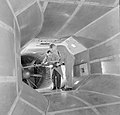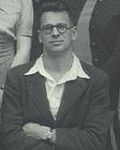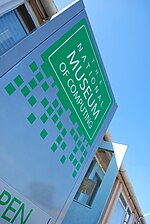EDSAC 2 was an early vacuum tube computer (operational in 1958), the successor to the Electronic Delay Storage Automatic Calculator (EDSAC). It was the...
4 KB (231 words) - 17:28, 5 November 2024
numbers. EDSAC was finally shut down on 11 July 1958, having been superseded by EDSAC 2, which remained in use until 1965. As soon as EDSAC was operational...
30 KB (3,373 words) - 09:00, 29 October 2024
inspired the world's first business computer, LEO. It was replaced by EDSAC 2, the first microcoded and bit-sliced computer, in 1958. In 1961, David...
17 KB (1,435 words) - 09:30, 19 October 2024
The version for the EDSAC 2 was devised by David Hartley of University of Cambridge Mathematical Laboratory in 1961. Known as EDSAC 2 Autocode, it was a...
9 KB (1,096 words) - 09:08, 17 November 2023
version for the EDSAC 2 was devised by Douglas Hartree of University of Cambridge Mathematical Laboratory in 1961. Known as EDSAC 2 Autocode, it was...
39 KB (3,824 words) - 04:03, 28 October 2024
Maurice Wilkes (section EDSAC)
designed and helped build the Electronic Delay Storage Automatic Calculator (EDSAC), one of the earliest stored program computers, and who invented microprogramming...
26 KB (2,498 words) - 10:18, 11 October 2024
History of computing hardware (section EDSAC)
manufacturing company J. Lyons & Co. Ltd. EDSAC 1 was finally shut down on 11 July 1958, having been superseded by EDSAC 2 which stayed in use until 1965. The...
169 KB (17,662 words) - 07:36, 1 November 2024
developed by David Wheeler while working on the pioneering EDSAC machine in the 1950s. EDSAC had not been built with subroutines in mind, and lacked a...
3 KB (425 words) - 01:42, 30 March 2023
computationally intensive. In the early 1960s Peter Swinnerton-Dyer used the EDSAC-2 computer at the University of Cambridge Computer Laboratory to calculate...
25 KB (3,122 words) - 19:12, 1 November 2024
Atlas (computer) (section Titan and Atlas 2)
only two machines which are really fast are the Cambridge EDSAC 2 and the Manchester Mark 2, although both are still very slow compared with the fastest...
25 KB (3,075 words) - 15:27, 24 September 2024
Computing Engine Colossus computer CTL Modular One Digico Micro 16 EDSAC EDSAC 2 Elliott Brothers (computer company) Elliott 152 Elliott 503 Elliott...
4 KB (388 words) - 07:32, 7 September 2024
University Information Services department. EDSAC computer, 1949 - a pioneering stored-program computer EDSAC 2 computer, 1965 - first computer to have a...
4 KB (428 words) - 04:54, 25 October 2024
modern computer – Maurice Wilkes EDSAC 2 the successor to the Electronic Delay Storage Automatic Calculator or EDSAC. It was the first computer to have...
136 KB (13,436 words) - 20:19, 24 October 2024
field included work on the Electronic Delay Storage Automatic Calculator (EDSAC) in the 1950s and the Burrows–Wheeler transform (published 1994). Along...
15 KB (1,419 words) - 07:14, 13 September 2024
electronic computer. The vast increase in computing power that EDSAC and its successor EDSAC 2 supplied, contributed to the winning of three Nobel Prizes...
40 KB (4,630 words) - 12:48, 7 November 2024
Bit slicing (redirect from 2-bit architecture)
very-large-scale integration circuits). The first bit-sliced machine was EDSAC 2, built at the University of Cambridge Mathematical Laboratory in 1956–1958...
17 KB (1,606 words) - 10:20, 23 June 2024
developing the first programming language "Autocode", and its compiler for the EDSAC 2 computer, for which he was awarded a PhD degree in 1963. His thesis was...
15 KB (1,303 words) - 23:31, 6 January 2024
computer, built by the Metropolitan-Vickers Company of Manchester. 1958: EDSAC 2, the first computer to have a microprogrammed (Microcode) control unit...
160 KB (16,728 words) - 20:18, 24 October 2024
(link) "COMPUTERS, OVERSEAS: 4. Max-Planck-Institut fur Physik, G 1, G 1a, G 2, and G 3. Gottingen, Germany". Digital Computer Newsletter. 10 (3): 15–16...
27 KB (939 words) - 08:16, 7 November 2024
applications. The prototype LEO I was modelled closely on the Cambridge EDSAC. Its construction was overseen by Oliver Standingford, Raymond Thompson...
23 KB (2,605 words) - 15:00, 4 August 2024
Two's complement (redirect from 2's complement notation)
EDVAC proposal for an electronic stored-program digital computer. The 1949 EDSAC, which was inspired by the First Draft, used two's complement representation...
43 KB (5,450 words) - 04:58, 2 November 2024
Cambridge Mathematical Laboratory and contributed to the development of the EDSAC 2 computer. In the early 1960s, he was leader of software development in...
12 KB (991 words) - 19:05, 16 February 2023
Largest known prime number (redirect from 2^43112609 − 1)
Time. Time Inc. October 29, 2008. Archived from the original on November 2, 2008. Retrieved January 17, 2012. "GIMPS by Mersenne Research, Inc". mersenne...
26 KB (1,279 words) - 21:05, 9 November 2024
graphical computer game, OXO, a version of noughts and crosses, in 1952 on the EDSAC computer at University of Cambridge. Douglas was born on 21 May 1921 in...
9 KB (940 words) - 11:17, 12 May 2024
building, is decorated with a paper-tape representation of the original EDSAC "Initial Orders" (boot program) written by David Wheeler and of a program...
4 KB (333 words) - 20:12, 28 October 2024
America, but the von Neumann report inspired the construction of the E.D.S.A.C. (electronic delay-storage automatic calculator) in Cambridge (see p....
35 KB (4,257 words) - 06:15, 9 November 2024
The Preparation of Programs for an Electronic Digital Computer (section Chapter 7 - Examples of programs for EDSAC)
The book was based on the authors' experiences constructing and using EDSAC, one of the first practical computers in the world. It was the first book...
9 KB (809 words) - 21:22, 11 July 2024
far. — British newspaper The Star in a June 1949 news article about the EDSAC computer, long before the era of the personal computers. In the history...
90 KB (9,663 words) - 12:00, 5 November 2024
his team constructed EDSAC. A filing cabinet of punched tape held the subroutine library for this computer. Programs for EDSAC consisted of a main program...
26 KB (3,102 words) - 21:00, 3 November 2024
of computers. Lyons's LEO I computer, modelled closely on the Cambridge EDSAC of 1949, became operational in April 1951 and ran the world's first routine...
139 KB (14,027 words) - 12:44, 6 November 2024

















